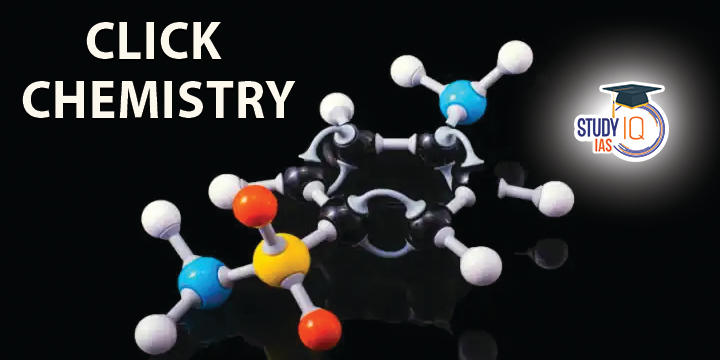Table of Contents
What is Click Chemistry
Click Chemistry is a newer approach that can accelerate the synthesis of molecules by utilizing a few practical, simple, and reliable reactions.
It was discovered by Huisgen in the 1950s; however, it was Barry Sharpless who coined the term ‘Click Chemistry‘.
Sharpless and coworkers defined what makes a Click Chemistry Reaction as one that is wide in scope and easy to perform, uses only readily available reagents, and is insensitive to oxygen and water.
In fact, in several instances water is the ideal reaction solvent, providing the best yields and highest rates.
Click Chemistry: Background
The problem with the traditional approach of molecule making
- Ever since the birth of modern chemistry in the eighteenth century, many chemists have used nature as their role model for creating complex molecules.
- However, one challenging problem is that complex molecules must be built in many steps, with each step creating unwanted by-products, making the process time consuming and very expensive to produce.
For example, The Haber-Bosch process
- It is an artificial nitrogen fixation process, which converts hydrogen and nitrogen to ammonia.
- It was developed it in the first decade of the 20th century and still the dominant way of producing cheap fertilizer and is at the heart of industrialized agriculture.
- However, this process is extremely energy intensive and polluting.
- This principle extends to most synthetic chemicals — where scientists try to create a natural substance, which is often circuitous and creates several unwanted toxic by-products.
Applications of Click Chemistry
- Drug discovery: Click Chemistry has found increasing applications in all aspects of drug discovery in medicinal chemistry, such as for generating lead compounds through combinatorial methods.
- Bioconjugation: click chemistry is rigorously employed in proteomics and nucleic research via bioconjugation.
- Radiochemistry: In radiochemistry, selective radiolabeling of biomolecules in cells and living organisms for imaging and therapy has been realized by click reactions.
- Nanoparticle modification: Click Chemistry Approach is generally used to conjugate the ligands, folate groups to the nanoparticles, which are then used for nanoparticle drug delivery.
- Bioorthogonal chemistry:
- The term bioorthogonal chemistry refers to any chemical reaction that can occur inside of living systems without interfering with native biochemical processes.
- Carolyn Bertozzi paved the way for bioorthogonal chemistry by discovering a copper-free click reaction, called the strain-promoted alkyne-azide cycloaddition (SPAAC).
- Applications of bioorthogonal chemistry:
- Biological imaging: Bioorthogonal reactions are widely used for the understanding of the structures and functions of biomolecules such as proteins, lipids, and glycans etc.
- Targeted drug delivery: Bioorthogonal reactions are used for the site-specific delivery of antitumor agents.
- Vivo imaging: It is the non-invasive visualization of living organisms for research or diagnostic purposes.

The Copper Catalyzed Azide-Alkyne Cycloaddition (CuAAC)
- It is often termed as the crown jewel of click chemistry.
- It is an efficient and straightforward chemical reaction that is now in widespread use.
- In this reaction, Azides and alkynes, in the presence of copper ions, combine to form a third kind of chemical structure called triazole.
- Triazoles are stable structures found in certain drugs and agricultural chemicals. Earlier attempts to make triazoles were inefficient and created undesirable by-products but copper changed the game.
- With the help of CuAAC, manufacturers can now make triazoles in a faster and efficient way.






















 WhatsApp
WhatsApp